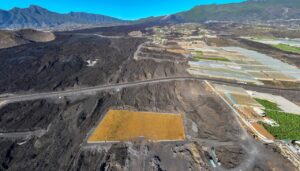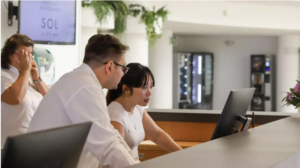22 Aug La Palma Reconstruction – July 2024

La Palma’s Reconstruction: July 2024 Update
News roundup from across La Palma regarding science occurring in La Palma, reconstruction efforts, aid provided to residents and industries, and other relevant news. Sources: La Palma Ahora, Cabildo de La Palma, El Time, ABC España, El Valle de Aridane, El Dia,
Mirame, Planeta Canario, Canarias 7, El Diario, National Geographic
Reconstruction
- 27 groups against reconstruction philosophy – A group of 27 associations and platforms have released a ‘Manifesto for La Palma’, which criticises the current philosophy of the recovery, claiming it prioritises a type of exploitative tourism model which has already failed on other Canary Islands, such as through the development of golfing resorts and luxury hotels.
- Bids to reconstruct CEIP La Laguna – 14 companies are bidding to rebuild the CEIP La Laguna School, which was partially destroyed by lava flows during the eruption. The resolution and award of the contract are expected to be announced later in July or August.
- Recovery of agricultural plots and livestock farms – The Cabildo de La Palma is calling for aid for investments in small agricultural holdings, and the recovery of currently abandoned agricultural plots, as part of the post-volcano recovery. The grants are open for six months and are also meant to potentially reduce forest fire risk by clearing the environment of fuel currently occupying the abandoned plots.
-

34 months after the volcano: this is how reconstruction looks for those affected I Love The World (El Valle de Aridane, 2024)
Photos of 34 months since the eruption – The audiovisual company ILoveTheWorld have returned to La Palma to document using drone photography the recovery of the island. Among the documented recovery activity are re-built banana plantations on top of the lava flows, many new access roads to areas isolated from the lava flows, and the recovering tourist area of Puerto Naos.
- Recovery of old Todoque road – Part of the route of the destroyed LP-211 road, close to where the town of Todoque was, has been opened. The total route of the LP-211 is 2.2 km long and €10.5 million has been allocated for the full works, which are expected to take 10 months.
- Regional approval of housing and agricultural decree – The housing and agricultural recovery decree laws have been approved by the Government of the Canary Islands. Among other laws, this allows the Cabildo de La Palma to build and buy protected housing for those affected by the volcano through the public company Visocan, which should improve the efficiency of the housing recovery. €5 million per year has been allocated to the town councils to purchase land on which to build protected housing.
- Cost of infrastructure reconstruction – The latest statistics from the Los Llanos de Aridane City Council show that the council estimates a total of €76 million is needed to recover just the affected infrastructure in the municipality.
Aid
- €150 million for those affected – The Ministry of the Presidency of the Government of the Canary Islands has published the payment order for the first annual payment of the plan for the restitution of the value lost due to the volcanic eruption. This affects 840 of the families whose first homes were destroyed and contains €150 million, with €100 million from the Spanish Government and €50 million from the regional Government of the Canary Islands. Of the 840 files of families whose first home was affected during the eruption, more than 500 have already been validated.
- Aid for families who return to their homes – The Cabildo de La Palma has announced it is working on a line of aid aimed at those affected returning to their homes outside exclusion zones, to encourage more to return. Further details have yet to be announced.
- Application deadline for registry of affected persons extended – The Government of the Canary Islands has approved a decree which extends the deadline for those affected by the volcano to apply to the registry of people affected by the eruption, until December 31st 2024. The registry was established to process aid more effectively, rapidly and efficiently.
- Special measures ratified by the Spanish Government – The Congress of Deputies in the Spanish Government has ratified the extension of measures aimed at helping the economic and social recovery of La Palma, including the 60% personal income tax deduction and beneficial changes to property tax and economic activities tax. The suspension of payment obligations for loans has also been extended for a further six months.
- Furlough – The latest figures show that 212 workers from 96 companies remain on furlough following a disruption to their employment activities from the volcanic eruption. Immediately following the eruption, this was as high as 2,000.
Science
Can't be happier with my team (Group B) as part of @GeoIntern ready to help @pabloj_gonzalez of @CSIC with his research project.🌋🔍 #LaPalma #Teamwork #ResearchCollab pic.twitter.com/IK8Uc74m4D
— Rosana Lopez (@Rosana_rocks) July 17, 2024
Another day of fieldwork! Today, we collected geochemistry samples from a lava channel of Tajuya Volcano with Danilo Cruz from @UF_CLAS @UFGeology .🌋 #Geology #Fieldwork #Volcanology @GeoIntern pic.twitter.com/s9X95IaihF
— Rosana Lopez (@Rosana_rocks) July 22, 2024
- GeoInterns undertake new research on La Palma – GeoTenerife’s annual GeoIntern Cohort spent July undertaking new collaborative research on Tenerife and La Palma with CSIC, IGN and the University of Florida. There were two projects on La Palma, looking at:
-
-
- A study alongside the University of Florida to study the geochemistry of the Tacande eruption lava flows in El Paso La Palma using a portable XRF analyser. This study aimed to determine if the Tacande and Tahuya lava are geochemically distinct, which could suggest the lavas were not erupted at the same time.
- A study alongside CSIC to study the location, orientation, and size of the cracks that have opened up on the houses of El Corazoncillo, Los Llanos to understand the volcanically induced strain in the area post-eruption.
-
- CO2 alert project – recovery and return of residents to Puerto Naos and La Bombilla
- Access to homes – A further nine households have been granted access to their homes in La Bombilla, taking the total number with access in Puerto Naos and La Bombilla up to 861 (808 and 53 between the two areas, respectively). Of these, 560 people have formalised the access requirements.
-

The Sol de Puerto Naos Hotel registers 60% occupancy in its first week reopened after the eruption (El Diario, 2024)
Reopening of Sol de Puerto Naos Hotel – The Sol La Palma hotel, the premier hotel in Puerto Naos, has reopened its doors for the first time since September 2021 after CO2 concentrations have remained at safe levels (below 700ppm) in its vicinity for a prolonged period. It has received 60% occupancy in its first week but is operating at half its accommodation capacity of 473 rooms. It has opened with 13 indoor and 2 outdoor gas meters.
- Bathing areas – The Varadero de La Bombilla has been approved for use once again as a bathing area.
- Other areas in Puerto Naos – A supermarket, two garages and a seafront commercial premises have been reopened, after having registered long-term concentrations below 700 ppm. The Cabildo de La Palma have stated they aim to provide individual solutions for reopening other business premises that remain closed for now.
- Monitoring network – A total of 1,156 gas meters are currently installed and connected to the network to monitor CO2 concentrations and issue alerts.
- Delta Biodiversity Project – The Delta Project, aimed at assessing offshore biodiversity impacts of the area of the sea affected by the 2021 eruption, is carrying out a biodiversity survey including citizen participation from locals who are freediving experts or species identification specialists.
- Study linking volcanic lightning to explosive activity – A group of scientists from INVOLCAN and ITER as well as universities in Munich, Germany and Bath, UK have studied the trends in volcanic lightning observed during the 2021 eruption. It suggests that different eruptive styles can affect the generation of lightning in volcanic plumes and that this could potentially used in real time to assess variations in eruption dynamics.
- New geothermal study – The University of La Laguna and the Geology and Mining Institute of Spain (IGME-CSIC) have signed an agreement for an in-depth study into the potential of La Palma for shallow geothermal energy less than 100 m below the surface, through a project called Sage4Can.
- Offshore 2021 lava flows surveyed – The Ecoaqua project led by the University of Las Palmas de Gran Canaria (ULPGC) has surveyed the offshore areas of the 2021 lava flows to analyse their colonisation. They have found that the deepest parts of the lava flows are found at 350 m depth, and these deepest parts of the flows have been colonised by black coral.
Other updates
ℹ️ Estudiamos junto a nuestros Servicios Jurídicos el caso que perjudica a 12 familias afectadas por la erupción volcánica, supuestamente estafada por una constructora
— Cabildo de La Palma (@CabLaPalma) July 5, 2024
🔗https://t.co/E94IgcJYCG pic.twitter.com/sc4GAMiNYR
- Appeal against the exclusion zone decree and traffic light – Francisco Pulido has appealed against the June decree that maintains exclusion zones and restricted access zones related to the volcano. He alleges that these current restrictions do not have a basis in current laws or civil protection plans. He also argues that the current designation of the volcanic alert level as ‘yellow’ goes against guidelines set out in the PEVOLCA plan, and the traffic light should be reduced to green (pre-alert).
- Lava delta pipeline fine increased – The Ministry of Ecological Transition has increased the fine for the alleged illegal construction of the Las Hoyas-El Remo pipeline across the lava delta (without environmental assessment or proper authorisation), from €1.3 million to €2.1 million. The latest sanctions also demand that the Island Water Council of La Palma restore the lava delta to its state before the construction of the pipeline.
- Building scam for those affected – Approximately a dozen families have fallen victim to a scam from an alleged builder offering to build new homes, but instead have faced non-compliance from the company and being left without finished homes.

No Comments